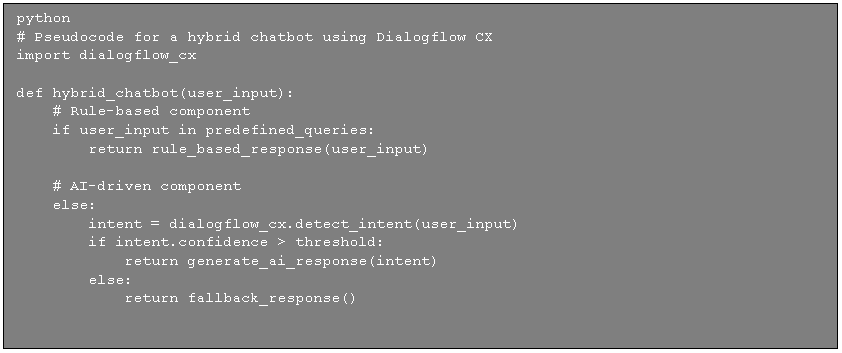Enjoy the best of both worlds with hybrid agents, which can handle both structured and unstructured user interactions.
Feb. 26, 2025 | By Clinton Hughes & Sowrabh Sanath Kumar
With the power of the latest technologies, your enterprise can implement conversational agents to assist with a number of tasks, including customer service and information retrieval. Unlike traditional chatbots with limited responses, conversational agents use natural language to simulate real human interaction more closely.
These hybrid chatbots combine the strengths of rule-based systems with the flexibility of AI-driven approaches. They efficiently address deterministic queries (predefined conversational paths) and probabilistic queries to deliver a more comprehensive conversational dialog. This hybrid approach is gaining traction in enterprise settings because of its versatility in managing structured and unstructured interactions effectively.
In this article series, we’ll explore insights from available research, enterprise use cases, decision-making criteria and implementation examples for hybrid conversational agents.
Combining Rule-Based and AI Components
Hybrid chatbots integrate rule-based systems with AI-driven components to create a more adaptable and effective user experience. The rule-based component handles common, predictable queries, while the AI component manages more complex, open-ended conversations. This combination allows hybrid chatbots to precisely execute a wide variety of tasks, regardless of complexity, with the agility to learn, adapt and improve.
To develop an AI hybrid conversational agent for your enterprise, consider incorporating the following components:
- Intent recognition: identifies the user’s underlying objective or query
- Entity recognition: extracts specific information, like dates, locations or product names, from user inputs
- Rule-based responses: handles straightforward, predictable queries in a structured manner
- Machine learning for complex tasks: manages more nuanced or open-ended interactions
- Fallback mechanisms: ensures the chatbot can still provide useful responses when uncertain
- Prompt engineering: crafts tailored instructions to guide generative AI in producing accurate, context-aware and relevant responses
- User context management: maintains conversation history for more coherent interactions
- API integration: enables the agent to interact with external systems, enhancing its response capabilities
- Performance tracking: monitors user interactions and analyzes data to continuously improve the agent’s performance
- Training data updates: regularly refines the agent’s training data to improve accuracy and responses based on performance insights
Personalization, Context Awareness and Enterprise Use Cases
Hybrid chatbots can retain conversation context and utilize user data to deliver personalized responses. Remembering user preferences and maintaining conversation coherence across multiple interactions results in an enhanced user experience. This personalization also enables the conversational agent to tailor its responses to individual needs, simulating a more realistic dialog experience.
Hybrid conversational agents are particularly valuable in enterprise settings where structured processes and complex interactions are common. Some key use cases include:
- Customer support: handling routine inquiries and complex problem-solving
- E-commerce: providing personalized shopping assistance and order processing
- Banking: answering straightforward queries and analyzing spending patterns
- Human resources: managing employee onboarding and answering policy questions
- IT support: troubleshooting common issues and escalating complex problems
- Healthcare: providing patient support and medical information
Deciding When To Use Hybrid Methods
While hybrid agents are particularly helpful in certain use cases, your organization doesn’t need to use them for every task. Instead, consider using a hybrid chatbot when:
- Dealing with a mix of simple and complex queries
- Requiring quick responses and in-depth problem-solving
- Needing to maintain context across multiple interactions
- Aiming to provide personalized experiences at scale
- Seeking to optimize resource utilization by automating routine tasks while preserving human touch for more complex issues
- Adapting to industry-specific needs
A Look at the Hybrid Approach in Dialogflow CX
Google Cloud’s Dialogflow CX is a natural language platform built on generative models. Dialogflow CX uses machine learning to foster more humanlike interactions and allows users to build hybrid conversational agents with both deterministic and generative AI functionality. Below is a conceptual example:
- Define intents and entities for common queries using Dialogflow CX’s rule-based system.
- Implement fallback mechanisms that trigger AI-powered responses for unmatched intents.
- Utilize Dialogflow CX’s integration with foundation models to generate contextual responses.

This example demonstrates how users can integrate Dialogflow CX’s intent detection with a custom AI response generation for unmatched intents. In this simple hybrid approach, rules handle predefined queries, while more complex inputs are processed using Dialogflow CX’s AI capabilities.
Enhance User Experience With Hybrid Conversational Agents
By leveraging hybrid chatbot architectures, enterprises can provide more efficient, personalized and scalable customer interactions while maintaining control over critical aspects of the conversation flows. Google Cloud’s Dialogflow CX is a powerful platform that enables developers to create sophisticated hybrid conversational agents, combining deterministic and generative AI functionality. This allows precise control over certain aspects of conversations while leveraging the flexibility and natural language capabilities of generative AI.

Clinton Hughes
Customer Solution Manager
Clinton Hughes provides thought leadership and actionable direction for TEKsystems’ Google Cloud practice as a customer solution manager. A seasoned professional in cloud technology with over 15 years of business intelligence, financial planning and cloud transformation experience, Clinton has diverse roles in engineering, program management and solution management that showcase a well-rounded perspective and position him to lead high-performing teams in their pursuit to deliver quantifiable and repeatable value.

Sowrabh Sanath Kumar
Solution Architect
Sowrabh Sanath Kumar, a solution architect in TEKsystems’ AI practice, drives solution development and innovation. With 15 years of experience, he leverages his expertise in CCAI, Gen AI and data analytics on Google Cloud Platform to craft compelling proposals, provide thought leadership and enhance TEKsystems’ service offerings.
Related Articles

Your Google Cloud Partner
Transformational technologies demand equally transformative partnerships. The world’s leading technology brands, including Google Cloud, work with us because of our scale, speed and quality—building upon their foundation to foster and share ideas that help our customers grow. With TEKsystems by your side, you can reap the benefits of best-in-class implementation, integration and support—making the most of your technology investments and powering next-gen innovation.

Clinton Hughes
Customer Solution Manager
Clinton Hughes provides thought leadership and actionable direction for TEKsystems’ Google Cloud practice as a customer solution manager. A seasoned professional in cloud technology with over 15 years of business intelligence, financial planning and cloud transformation experience, Clinton has diverse roles in engineering, program management and solution management that showcase a well-rounded perspective and position him to lead high-performing teams in their pursuit to deliver quantifiable and repeatable value.

Sowrabh Sanath Kumar
Solution Architect
Sowrabh Sanath Kumar, a solution architect in TEKsystems’ AI practice, drives solution development and innovation. With 15 years of experience, he leverages his expertise in CCAI, Gen AI and data analytics on Google Cloud Platform to craft compelling proposals, provide thought leadership and enhance TEKsystems’ service offerings.